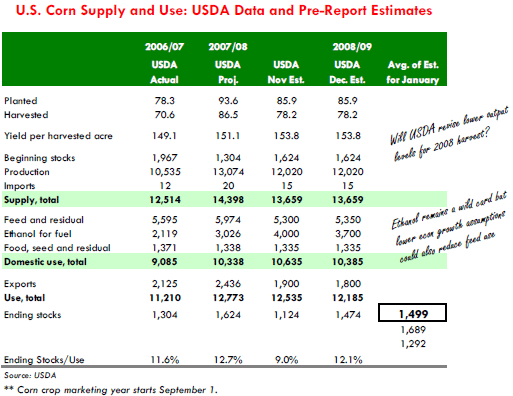



CME: Corn Export Outlook Poses Questions
US - CME's Daily Livestock Report for 8 Januaray 2009.USDA will is to release today the monthly update of its working supply and demand estimates for the 2008-09 marketing year and trade as usual will pay close attention. It is a particularly difficult job given the current upheaval in the US and global financial markets and prospects of a very difficult economic year ahead.
Recent forecasts from the Congressional Budget Office point to a 2.2 per cent decline in US GDP in 2009 and government deficits at 8.3 per cent of GDP, well above the 6 per cent reached in 1983. Global markets also remain in turmoil and the lack of willingness to invest in anything but US treasuries continues to support the value of the US dollar. How long that continues in the face of ballooning US deficits and the much faster printing presses at the Federal Reserve that is another matter. This is all germane to the issue at hand. One of the big questions for the market going forward is the outlook for US corn exports.
In the last USDA report, corn exports were pegged at 1.8 billion bushels, 100 million bushels lower than the November estimate and 636 million bushels or 26 per cent lower than the previous year. If the US dollar remains strong and the global economy continues to flounder, such an assumption would make sense and exports could eventually be even lower than current estimates. We have yet to see signs of a rebound in exports, as weekly shipments since October have been some 40 per cent behind last year’s levels. As for ethanol demand, that remains a big question mark.
Energy markets continue to be very volatile. Crude prices staged a notable recovery recently, gaining some $15 per barrel in a matter of days. But crude values then lost ground again on reports that US oil stocks continued to rise in December as US consumers travel less and the US economic activity declined. We know what oil prices are likely to be with a fast growing global economy, what is unknown is where they are likely to bottom out if the US economy contracts by 2.2 per cent. A $30 target does not seem such a bad number and at that that level it will be difficult to justify paying $4+ for corn, as current futures indicate. Finally, the slowing economy and the new found American desire to stash money away rather than spend it at the mall or the local restaurant or the nice beach vacation, will continue to impact meat prices. Meat producers still are feeling the whiplash of the price volatility and in the face of all this they are more likely to cut production, further eroding demand for corn.









